Every year, more than ten million Britons holiday in France – lured by the wine, weather and laid-back pace of life.
But what most of us don’t realise is that, just a few steps from the boulangeries and beaches, lies one of the antiques world’s best-kept secrets . . .
Scattered across sleepy villages and sun-baked town squares are brocantes – part flea market, part antiques emporium and, for those in the know, a goldmine.
For decades, the UK’s top interior designers and dealers have quietly scoured these French markets, snapping up vintage treasures for a handful of euros and selling them back home for a serious profit.
But there is no reason holidaymakers can’t do the same. You can turn a morning’s rummage into a lucrative side hustle, unearthing bargains hiding in plain sight.
I’ve been in Normandy this summer with my partner, who is the executive producer of television show Chateau DIY.
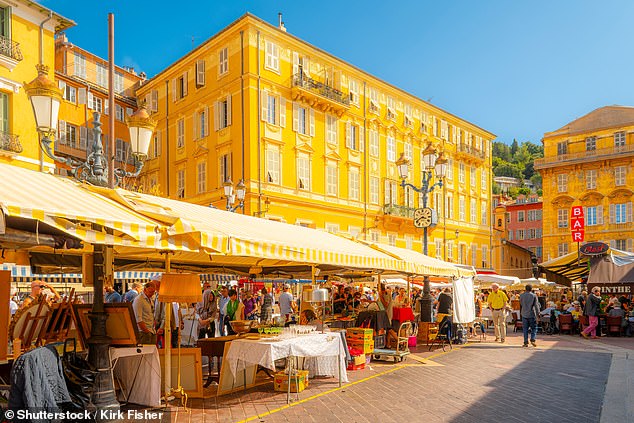
Hidden treasure: A trip to a brocante, such as this one in Nice in the South of France, is likely to unearth all sorts of antiques
While he is knee-deep in turrets, tiles and restoration chaos, I’ve been busy unearthing hidden gems in barns, market stalls and dusty attics.
I’ve wandered the brocantes – there are 50,000 of them in France – and have made finds that would make UK dealers go weak at the knees. And the best part? Many items go for pocket change.
Whether you’re planning your own French escape or just fancy making a few quid from forgotten gems, here are the tips, tricks and trade secrets. From vintage fashion to enamelware, old signage to antique mirrors, here’s how to bag a bargain.
What exactly is a brocante?
In France, the term covers anything from a ramshackle car-boot-style affair to a sprawling antiques warehouse.
Some are one-day pop-ups in village squares; others are permanent fixtures, more like an eccentric charity shop crossed with a museum.
At one end of the scale, locals lay out bric-a-brac on trestle tables. At the other, you’ll find glass-cabinet showrooms with labelled price tags and a rarefied air.
Some feel like rummaging through your great-aunt’s attic; others like stepping into an old-world department store.
What unites them is that irresistible sense of discovery, that tingle you get when, between a chipped jug and a taxidermy goose, you spot a 19th-century painting, an original Chanel belt or a mid-century lamp worth ten times the asking price.
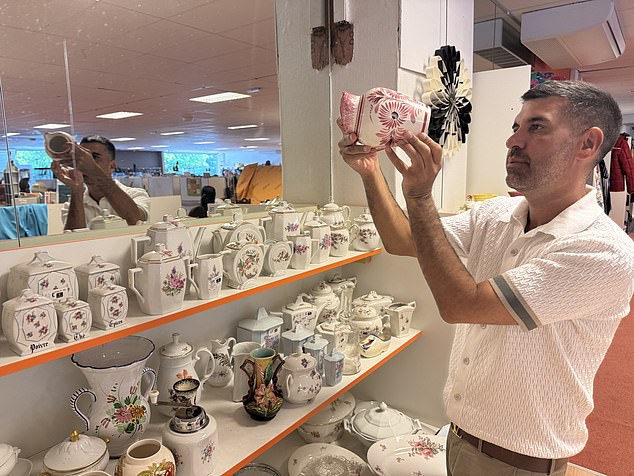
Examining the goods: Money-making expert Dan Hatfield checks out ceramics at a French Brocante
Why there are bargains to be had
France is awash with treasures because of two factors: abundance and attitude.
The French have held on to their stuff. Where post-war Britain embraced minimalism and cleared the decks, French families tended to keep heirlooms.
Homes stayed in the same family for generations, along with hand-embroidered linens, silverware, antique furniture and religious iconography.
These items trickle down into the brocante circuit via inheritance, house clearances and estate sales.
And culturally? If it’s out of style or no longer useful, many French see it as just old, not ‘vintage’.
Where a British dealer sees ‘shabby chic’, a French seller might call it ‘tat’. For treasure- hunters, that’s pure opportunity.
Six items to watch out for: 
- Art Deco mirrors (1920s–1930s)
With their clean lines, bevelled glass and often gilded or chrome frames, French Art Deco mirrors are a favourite among interior designers and still surprisingly easy to find at rural brocantes.
Think geometric shapes, stylised florals or sunburst motifs. In the UK, these often fetch £100 to £300, yet they can be picked up for as little as 20 euros (£17).
Check for: Silvering loss (those cloudy patches), but a little ageing can add character.
- Vintage linens and monogrammed textiles
No one does bed, table or tea linens quite like the French.
Think crisp white cotton or heavy linen with red embroidered monograms, delicate lace trim or hand-stitched hems.
These once made up a bride’s trousseau, and families kept them for generations. Now? They’re often sold off in bundles for a few euros apiece.
What to do with them: Frame a monogrammed napkin, use a lace tablecloth as a curtain or resell online where prices can reach £30 to £100.
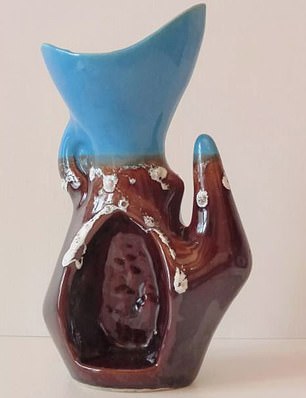
- Mid-century ceramics (1950s–1970s)
France had a huge ceramic boom in the post-war period, and pieces by lesser-known studios are still flying under the radar.
Look for bold colours, unusual glazes and chunky modernist shapes. Vallauris pottery, especially in lava-glazed or atomic styles, is collectable. I picked up a similar piece for 12 euros (£10) and had it valued at £350.
Watch out for: Makers’ marks under the base (such as Accolay, Le Vaucour or La Borne). Chips and cracks will devalue.
- Antique enamelware (1900s-1940s)
Nothing says French country kitchen like a pastel enamel coffee pot, flour tin or pitcher.
Blue- speckled, pink, white with navy trim or floral-painted pieces have become hot property for rustic, farmhouse-style interiors in the UK.
You can scoop these up for five to 15 euros (£4 to £13) a piece. They resell for £40 to £120.
Prop tip: Check the rims and handles. Minor rust is fine but holes or deep cracks kill the value.
- Designer fashion & accessories (1940s–90s)
You would be amazed what gets overlooked on the clothing rails at brocantes.
A well-worn Chanel belt, a Hermes scarf buried in a box of polyester or a YSL jacket priced as ‘old woman’s clothing’.
Vintage French fashion, especially pre-2000, is collectable and wearable and a savvy buyer can flip a ten-euro (£9) find into a three-figure profit.
Insider trick: Scarves are an easy win. Look for silk, hand-rolled edges and discreet branding. Designers such as Lanvin, Chloe or Celine offer strong resale value.
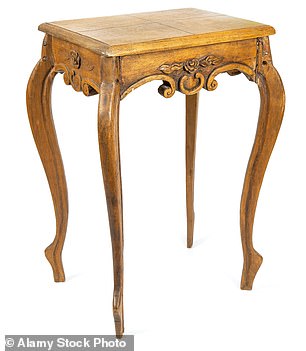
Yes, you can still find the odd bargain when it comes to French furniture, especially if it’s too large or ornate for the average local buyer to bother with.
Look for pieces with cabriole legs, scalloped aprons and floral carvings. Even if it’s a 19th-century revival piece rather than a 1700s original, it’s still highly desirable in the UK.
I’ve seen such pieces being offered for £100 to £200 when their worth in Britain would be ten times that figure.
Insider tip: Most French sellers won’t ship, so if you fall in love with a chair or commode, be prepared to hire a local delivery company or bring a van.
Dan’s five golden rules for antiques
- Haggle with charm: A smile and ‘Vous pouvez faire un petit prix?’ (can you give me a small discount?) works wonders.
- Cast a wide net: Hit as many brocantes as possible.
- Look beyond the dust: Cobwebs could be hiding gold.
- Bring cash: Sellers love it and may be more flexible on the price.
- Protect your finds: Bubble wrap is your best friend.
If you bring brocante home
- You have a £390 personal allowance. If you go over this, you may pay 20 per cent VAT plus duty (usually 2.5-6 per cent).
- Antiques more than 100 years old could save you money. If your items are genuinely over 100 years old and you can prove it, they may qualify for reduced VAT (5 pc) and no duty.
- Shipping big items home? Remember that import fees still apply, so get a clear breakdown before buying.
- Selling on? If you’re planning to sell items on, you can earn less than £1,000 before HMRC deems you a trader. After that, you will need to register for self-assessment and declare your earnings.
- Don’t fib on value: Be truthful with Customs because telling a white lie comes with the risk of fines or even confiscation.
Next time you’re in France with a baguette in one hand and rosé in the other, take a detour from the tourist traps.
Wander through a brocante, rummage with purpose, and you might just find that dusty old jug or forgotten frock will pay for your next holiday.
After all, one person’s vieux is another person’s cha-ching.
Bon chasse!
- Dan Hatfield is the resident money-making expert on ITV’s This Morning, valuation expert on the Daily Mail’s finance website This Is Money and is a third-generation pawnbroker. If you want him to value an item from your home email moneymail@dailymail.co.uk.
Rattan sun-lounger and vintage vases – my summer haul
Rattan sun-lounger (1940s): This beautiful garden piece is in fabulous condition for its age. The ticket price is 49 euros (£42). However, the top-end price of £400 would be achievable.
Walnut Louis Philippe-style armoire (late 19th century): This is in incredible condition. It is typical of what you would find in a chateau.
The price tag was 195 euros (£168). You could sell this back home for £600 to £800.
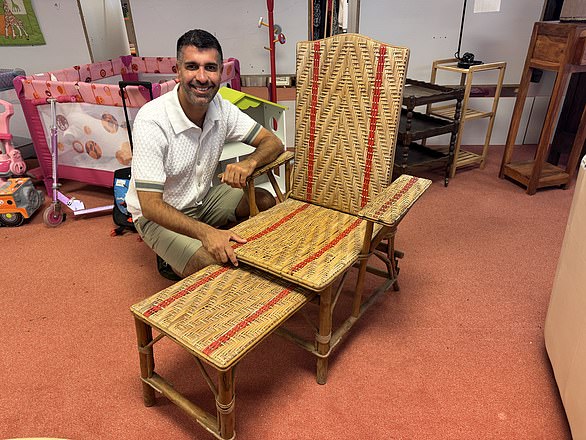
Top find: This 1940s Rattan sun-lounger is in fabulous condition for its age and could fetch as much as £400
‘La Voix de Son Maitre’ sign (circa 1958): Literally ‘The Voice of His Master’ is the French division of His Master’s Voice (HMV), originally part of the Gramophone Company and later EMI.
The iconic logo, a dog listening to a gramophone, is instantly recognisable, and it adds serious vintage appeal.
This sign hails from around 1958. The price tag was 49 euros (£42) yet the re-sell value is around ten times that at up to £400.
Thulin twin-handled vases (circa 1900): These beautiful twin-handled vessels were produced around the 1900s.
Thulin was a major ceramic factory known for its fine Art Nouveau forms and distinctive sinuous shapes, often featuring flowing lines and rich glazes.
I picked them up for eight euros (£9) yet the pair will sell for £400.
Sunflower Pyrex dish (1970s): A long way from home, this American creation, once considered naff, is now highly collectable.
It is being sold for two euros (£1.70) and could be resold for £30.
